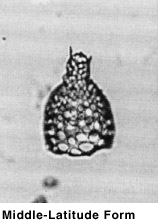 Lamprocyrtis
nigriniae (Caulet)
Lamprocyrtis
nigriniae (Caulet) Lamprocyrtis
nigriniae (Caulet)
Lamprocyrtis
nigriniae (Caulet)Conarachnium ? sp. Nigrini, 1968, p.56, pl.1, fig.5a (partim.)
?Conarachnium? sp. Nigrini, 1968, p.56, pl.1, fig.5b (partim.)
Conarachnium nigriniae Caulet, 1971, p.3, pl.3, figs.1-4, pl.4, figs.1-4
Lamprocyrtis haysi Kling, 1973, p.639, pl.5, figs.15-16, pl.15, figs.1-3
Lamprocyrtis nigriniae (Caulet), Kling, 1977, p.217, pl.1, fig.17
Two-segmented forms with hemispherical to cylindrical [three-lobed] cephalis, commonly open, with irregularly arranged circular to elliptical pores and a three-bladed apical spine and usually one or more accessory spines. Collar stricture indistinct. Thorax inflated conical, thin-walled, smooth, with subcircular (rarely elliptical to irregular) pores generally aligned in longitudinal and transverse rows (rarely irregularly arranged) and gradually increasing in size distally. Thorax terminates, sometimes slightly constricted, with an irregular row of small teeth; a weak peristome is seldom developed (Kling, 1973).
See also Nigrini (1968) and Caulet (1971).
 DIMENSIONS
DIMENSIONSMaximum width 80-90 µm; length from top of cephalis 100-150 µm; thoracic pores 2-20 µm (Kling, 1973).
The thoracic breadth given by both Nigrini (1968) and Caulet (1971) is greater than that found by Kling for North Pacific specimens. For this reason Kling only tentatively included the specimen figured by Nigrini (1968) on pl.1, fig.5b.
A small form with only two segments, the pores of the second increasing in size gradually from collar stricture to distal margin. Distal margin has a differentiated peristome. There is no abrupt change in size between distal and proximal thoracic pores as in its ancestor L. neoheteroporos (Riedel and Sanfilippo, 1978a).
L. nigriniae is distinguished from L. neoheteroporos by the pores increasing regularly in size, rather than abruptly across a circumferential discontinuity. It differs from co-occurring Anthocyrtidium spp. in having a thicker shell with pore size increasing distally (Sanfilippo et al., 1985).
In this two-segmented pterocorythid, the pore size increases distally in a regular fashion. Like its ancestor, L. neoheteroporos, L. nigriniae varies from small, compact, heavy-shelled forms (100 µm in length) to longer (up to 160 µm), more broadly flared, open latticed forms with lighter bars. The latter variety is often broken before the termination, whereas the former usually terminates in a slightly constricted, weak peristome. Both extremes co-occur in low-latitude sites, but at DSDP Sites 173 and 310 only the smaller, more compact form occurs (Sanfilippo et al., 1985).
The species is not found in latitudes higher than 45°. It is relatively rare in tropical open ocean sediments, but more abundant in middle latitudes in areas of upwelling. L. nigriniae is restricted to the middle and late Quaternary. In low latitudes its morphotypic first appearance lies within the Anthocyrtidium angulare Zone. In middle latitudes its morphotypic first appearance lies within the Eucyrtidium matuyamai Zone. It is extant.
L. nigriniae is an extant species that evolved from L. neoheteroporos. See also discussion under Phylogeny of L. heteroporos.
Additional illustrations can be found in Goll, 1980, pl.3, fig.10.